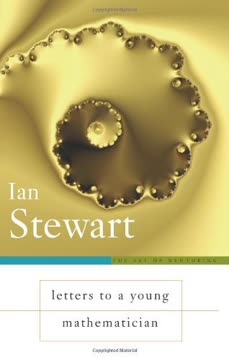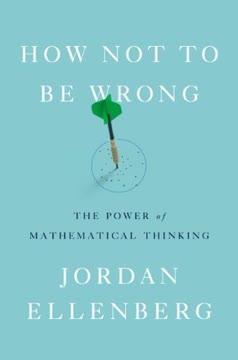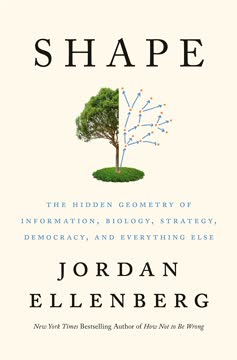Key Takeaways
1. Mathematics: A Universal Language Shaping Our World
"You go onto the Internet to get a plane ticket, book your flight and turn up at the airport, hop on the plane, and away you go. The plane flies because the engineers who designed it used the mathematics of fluid flow, aerodynamics, to make sure it would stay up."
Mathematics is ubiquitous. From the algorithms powering internet searches to the aerodynamics of flight, mathematics underpins much of our modern world. Its applications span diverse fields:
- Internet security: Number theory in encryption
- Telecommunications: Coding theory and signal processing
- Transportation: GPS systems and traffic flow modeling
- Finance: Risk assessment and market predictions
- Medicine: Image processing in diagnostics
Mathematical thinking enhances problem-solving. Beyond specific applications, mathematical reasoning provides a framework for analyzing complex systems and making informed decisions across various domains of life and work.
2. The Art of Mathematical Proof: Storytelling with Logic
"A proof is a story told by mathematicians to mathematicians, expressed in their common language."
Proofs as narratives. Mathematical proofs are not just sequences of logical steps, but compelling stories that explain why something is true. They have:
- A beginning (hypotheses)
- A middle (logical arguments)
- An end (conclusion)
Beauty in simplicity. The most elegant proofs often have a clear, concise storyline that reveals deep connections between seemingly unrelated concepts. This narrative approach to proof makes mathematics more accessible and engaging, even for non-specialists.
3. Pure vs. Applied Mathematics: A False Dichotomy
"All areas of mathematics are potentially applicable, although—as with equality in Animal Farm—some are more applicable than others."
Interplay of pure and applied math. The distinction between pure and applied mathematics is often artificial and counterproductive. Many abstract mathematical concepts have found unexpected applications:
- Number theory in cryptography
- Topology in data analysis
- Group theory in particle physics
Value of abstract thinking. Exploring mathematics for its own sake often leads to powerful tools that find applications years or decades later. This highlights the importance of supporting both theoretical and practical mathematical research.
4. The Creative Process in Mathematical Discovery
"Poincaré called the first stage 'preparation,' the second 'incubation followed by illumination,' and the third 'verification.'"
Stages of mathematical creativity:
- Preparation: Conscious work on the problem
- Incubation: Subconscious processing
- Illumination: The "aha!" moment
- Verification: Formal proof and communication
Cultivating mathematical insight. Mathematicians can foster creativity by:
- Reading widely across disciplines
- Collaborating with diverse thinkers
- Allowing time for subconscious processing
- Pursuing interesting questions, even without immediate applications
5. Teaching Mathematics: Empathy and Understanding
"To my mind, the most important feature of good teachers is that they put themselves in the student's position."
Effective math teaching requires:
- Clear explanations of concepts
- Patience with different learning styles
- Encouragement of curiosity and exploration
Addressing misconceptions. Many students struggle with math due to past negative experiences or gaps in understanding. Good teachers identify these issues and provide targeted support to build confidence and competence.
6. The Global Mathematical Community: Collaboration and Connection
"Mathematics, like all the sciences, has always been international."
Fostering international collaboration. The mathematical community thrives on:
- Conferences and symposia
- Visiting professorships and research exchanges
- Online forums and preprint servers (e.g., arXiv)
Benefits of community. Active participation in the mathematical community provides:
- Exposure to new ideas and techniques
- Feedback on ongoing research
- Career opportunities and mentorship
- A sense of belonging and shared purpose
7. Navigating a Career in Mathematics: Challenges and Opportunities
"There is no danger that we will ever run out of new problems to solve."
Career paths in mathematics:
- Academia: Research and teaching
- Industry: Data science, finance, tech
- Government: National laboratories, intelligence agencies
Keys to success:
- Develop a broad mathematical foundation
- Cultivate strong communication skills
- Stay current with emerging fields and applications
- Build a network within the mathematical community
- Be open to interdisciplinary collaborations
8. The Beauty and Power of Abstract Thinking in Mathematics
"Nature is always deeper, richer, and more interesting than you thought, and mathematics gives you a very powerful way to appreciate this."
Mathematical abstraction reveals hidden patterns. By stripping away non-essential details, mathematicians can uncover fundamental structures that apply across diverse phenomena:
- Symmetry groups in physics and chemistry
- Topology in data analysis and materials science
- Differential equations in biology and economics
Cultivating mathematical intuition. Regular engagement with abstract mathematical concepts enhances one's ability to recognize patterns and connections in complex systems, both within and outside of mathematics.
9. Mathematics Education: Balancing Rigor and Intuition
"It's amazing how often teaching reveals hidden assumptions or unquestioned features of your own mathematical background."
Effective math education combines:
- Rigorous logical reasoning
- Intuitive understanding of concepts
- Real-world applications and examples
Addressing common challenges:
- Overcoming math anxiety and negative past experiences
- Bridging gaps in foundational knowledge
- Cultivating problem-solving skills beyond rote memorization
Educators should strive to make mathematics accessible while maintaining its intellectual depth and rigor.
10. The Role of Computers in Modern Mathematics
"Anyone who thinks computers can supplant mathematicians understands neither computing nor mathematics."
Computers as tools, not replacements. Computers enhance mathematical research through:
- Numerical simulations and data analysis
- Visualization of complex structures
- Automated theorem proving and verification
Limitations of computational approaches:
- Inability to provide deep conceptual insights
- Potential for numerical errors in floating-point arithmetic
- Difficulty in handling abstract or infinite structures
The most effective mathematical work combines human intuition and creativity with computational power.
Last updated:
FAQ
What's "Letters to a Young Mathematician" about?
- Overview: "Letters to a Young Mathematician" by Ian Stewart is a collection of letters offering guidance and insights to an imaginary young mathematician named Meg. It covers her journey from high school to becoming a tenured professor.
- Purpose: The book aims to demystify the world of mathematics, providing career advice, and exploring the culture and community of mathematicians.
- Structure: It is structured as a series of letters, each addressing different stages and aspects of a mathematical career, from choosing a field to understanding complex mathematical concepts.
Why should I read "Letters to a Young Mathematician"?
- Insightful Guidance: The book offers valuable advice for anyone considering a career in mathematics, making it a useful resource for students and educators alike.
- Cultural Understanding: It provides a deep dive into the culture and community of mathematicians, helping readers understand the social dynamics of the field.
- Inspirational Stories: Through personal anecdotes and historical references, the book inspires readers by showcasing the beauty and creativity inherent in mathematics.
What are the key takeaways of "Letters to a Young Mathematician"?
- Mathematics is Creative: The book emphasizes that mathematics is not just about numbers and formulas but is a deeply creative and imaginative field.
- Career Advice: It offers practical advice on navigating a career in mathematics, including choosing a thesis advisor and understanding the academic hierarchy.
- Mathematical Philosophy: Stewart discusses the philosophical aspects of mathematics, such as the nature of proofs and the role of mathematics in understanding the universe.
What are the best quotes from "Letters to a Young Mathematician" and what do they mean?
- "A proof is a story": This quote highlights the narrative nature of mathematical proofs, suggesting that they are not just logical sequences but also engaging tales that convey understanding.
- "Mathematics is the science of significant form": This quote by Lynn Arthur Steen, referenced in the book, captures the essence of mathematics as the study of patterns and structures that hold significance.
- "Keep your mind open, but not so open that your brains fall out": This humorous advice underscores the importance of being open to new ideas while maintaining critical thinking.
How does Ian Stewart define mathematics in "Letters to a Young Mathematician"?
- Science of Patterns: Stewart describes mathematics as the science of significant form, focusing on patterns and structures.
- Human Activity: He emphasizes that mathematics is a human activity, a social phenomenon that evolves within a cultural context.
- Logical Consistency: Mathematics is portrayed as a field governed by logical consistency, where proofs provide certainty and understanding.
What career advice does Ian Stewart offer in "Letters to a Young Mathematician"?
- Choosing an Advisor: Stewart advises selecting a thesis advisor who is not only knowledgeable but also supportive and compatible with your working style.
- Balancing Research and Teaching: He stresses the importance of balancing research with teaching responsibilities, as both are crucial for a successful academic career.
- Networking: Building a network within the mathematical community is essential for collaboration and career advancement.
How does "Letters to a Young Mathematician" address the fear of proofs?
- Understanding Proofs: Stewart explains that proofs are essential for ensuring the correctness of mathematical statements, providing a logical foundation for further work.
- Proofs as Stories: He likens proofs to stories, suggesting that they should be engaging and convey a clear narrative to aid understanding.
- Overcoming Fear: The book encourages readers to view proofs as opportunities for discovery and learning, rather than obstacles.
What is the significance of the Poincaré conjecture in "Letters to a Young Mathematician"?
- Historical Context: The Poincaré conjecture is presented as one of the great unsolved problems in mathematics, highlighting its importance and complexity.
- Recent Developments: Stewart discusses Grisha Perelman's work on the conjecture, illustrating the ongoing nature of mathematical research and discovery.
- Mathematical Impact: The conjecture's resolution has significant implications for the field of topology and the understanding of three-dimensional spaces.
How does Ian Stewart view the relationship between pure and applied mathematics?
- Interconnected Fields: Stewart argues that the distinction between pure and applied mathematics is becoming increasingly blurred, with both fields benefiting from each other.
- Practical Applications: He emphasizes that pure mathematics often finds unexpected applications in the real world, demonstrating its value beyond theoretical exploration.
- Unified Discipline: The book advocates for viewing mathematics as a unified discipline, where different approaches and methods contribute to a greater understanding.
What role does creativity play in mathematics according to "Letters to a Young Mathematician"?
- Essential Element: Creativity is portrayed as a fundamental aspect of mathematics, driving innovation and discovery.
- Problem Solving: Creative thinking is crucial for solving complex problems and developing new theories and concepts.
- Inspiration from Nature: Stewart highlights how nature inspires mathematical creativity, with patterns and structures providing a rich source of ideas.
How does "Letters to a Young Mathematician" address the challenges of teaching mathematics?
- Engaging Students: Stewart emphasizes the importance of making mathematics engaging and accessible to students, using clear explanations and relatable examples.
- Understanding Student Perspectives: He advises teachers to consider the student's perspective, recognizing that what seems obvious to an expert may be challenging for a beginner.
- Balancing Content and Creativity: The book suggests balancing the teaching of mathematical content with fostering creativity and critical thinking skills.
What is Ian Stewart's perspective on the mathematical community in "Letters to a Young Mathematician"?
- Supportive Network: Stewart describes the mathematical community as a supportive network that offers encouragement, collaboration, and shared knowledge.
- Global Reach: The community is portrayed as international, with mathematicians connecting across borders to advance the field.
- Cultural Identity: Being part of the mathematical community is seen as a source of pride and identity, with shared values and goals.
Review Summary
Letters to a Young Mathematician receives generally positive reviews, with readers praising its engaging style and valuable insights into the world of mathematics. Many find it inspiring and recommend it to aspiring mathematicians. The book is commended for its accessibility, humor, and ability to convey the beauty of mathematics. Some readers note that certain sections may be more relevant to those already pursuing mathematics, while others suggest it could have provided deeper insights. Overall, it's seen as a motivational and informative read for those interested in mathematics as a career.
Similar Books
Download PDF
Download EPUB
.epub digital book format is ideal for reading ebooks on phones, tablets, and e-readers.









